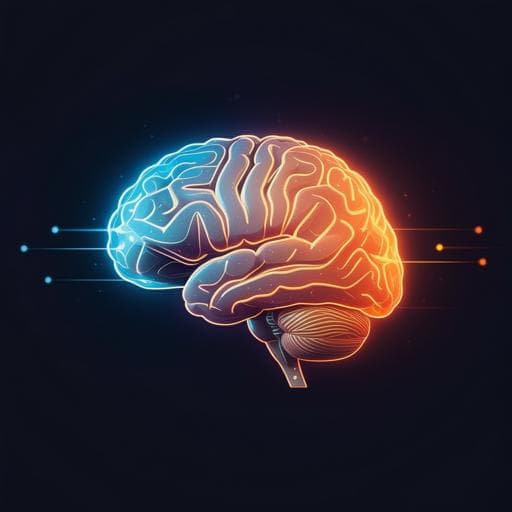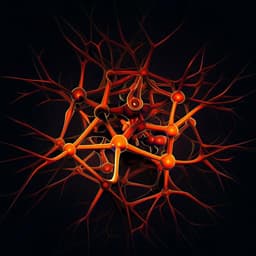
Psychology
Cognitive functions and underlying parameters of human brain physiology are associated with chronotype
M. A. Salehinejad, M. Wischnewski, et al.
This research reveals how individual chronotypes—morning or evening preferences—affect brain function and cognitive abilities. Conducted by Mohammad Ali Salehinejad and colleagues, the study found enhanced motor learning and cognitive performance at preferred times of the day, linked to changes in cortical excitability and neuroplasticity.
~3 min • Beginner • English
Introduction
The study investigates whether and how human chronotype (morningness-eveningness) modulates brain physiology and cognition. Given established circadian influences on physiological processes and increasing decoupling of lifestyle from the 24-hour cycle, the authors aim to determine the interaction of chronotype and time-of-day on cortical excitability, stimulation-induced neuroplasticity, and associated behaviors including motor learning, working memory, and attention. The work is motivated by implications for well-being, education, work, and clinical interventions, and leverages non-invasive brain stimulation and EEG to link physiological mechanisms (glutamatergic facilitation and GABAergic inhibition) to cognitive performance across circadian-preferred versus non-preferred times in early (morning-type) and late (evening-type) chronotypes.
Literature Review
Prior work shows circadian modulation of basic physiology and cognition, with a strong research focus on molecular and cellular mechanisms. Non-invasive brain stimulation (TMS, tES/tDCS) enables assessing and modulating cortical excitability and plasticity in humans, tied to neurotransmitter systems (glutamatergic, GABAergic, cholinergic). Animal studies reveal circadian impacts on hippocampal plasticity and LTP; invertebrate and human studies suggest circadian modulation of neural/cortical excitability. Human studies report circadian regulation of cortical excitability and inhibitory circuits, and that paired-associative stimulation effects can vary by time of day. However, explicit chronotype-dependent effects on human cortical excitability, plasticity, and cognition remain underexplored. The authors position their study to fill this gap by integrating physiology (TMS/tDCS), behavior (motor learning and cognition tasks), and EEG markers across chronotypes and times of day.
Methodology
Design: Within-subject manipulation of time-of-day (morning vs evening) crossed with between-subject chronotype (early chronotypes [ECs] vs late chronotypes [LCs]) in healthy adults. Physiological measures (TMS-based excitability protocols; tDCS-induced plasticity), behavioral tasks (motor sequence learning and cognitive tasks), and EEG ERPs were collected in separate sessions. Sleep/wake schedule, ambient light (~500 lux), and session timing were controlled; subjective sleepiness (KSS) and resting EEG theta/alpha were monitored as indirect sleep pressure markers.
Participants: N=32 (16 EC, 16 LC; 16 females; mean age 26.62±5.01). Right-handed, non-smokers, screened for neurological conditions. Chronotype determined via German Morningness-Eveningness Questionnaire (DMEQ); only moderate chronotypes included (EC mean score 62.25±3.47; LC 35.37±4.31). Gender balanced; females not tested in luteal phase. Sessions spaced ≥1 week; participants instructed to have ≥8 h sleep before sessions; caffeine/strenuous activity restricted.
Session timing: Fixed times selected from prior actimetry-based activity profiles: morning ~08:00; evening ~19:00 (tDCS started ~08:30 and ~19:00). ECs’ preferred time: morning; LCs’ preferred time: evening.
Physiology—TMS protocols: Conducted over left primary motor cortex (M1), recording motor-evoked potentials (MEPs) from right abductor digiti minimi (ADM). Equipment: PowerMag2 stimulator; EMG acquisition and Signal software. Protocols included: (1) Input–Output (I–O) curve at 100%, 110%, 130%, 150% of RMT; (2) Short-interval intracortical inhibition/facilitation (SICI-ICF) with conditioning at 70% AMT and test pulse set to 2–5 mV baseline MEPs; ISIs 2, 3 ms (inhibition), 10, 15 ms (facilitation) plus 5 ms; (3) I-wave facilitation with suprathreshold test and subthreshold second pulse at early (1.1–1.5 ms), middle (2.3–2.9 ms), and late (4.1–4.5 ms) ISIs; (4) Short-latency afferent inhibition (SAI) combining peripheral ulnar nerve stimulation (20–40 ms ISIs) with M1 TMS. Baseline single-pulse measures (RMT/AMT; S1mV) were established; MEPs normalized to test pulse for paired-pulse protocols.
Physiology—tDCS plasticity: tDCS (neuroConn; 35 cm² sponges) over left M1 (C3) with return over right supraorbital (Fp2). Three conditions: anodal, cathodal, sham; 1 mA for 7 min (30 s ramp up/down). Six sessions per participant (morning/evening × anodal/cathodal/sham) in randomized order, ≥1 week apart. After tDCS, single-pulse TMS MEPs (S1mV) were recorded at baseline and at 0, 5, 10, 15, 20, 25, 30 min post-stimulation (25 MEPs per timepoint). Blinding efficacy and side effects assessed; sham produced no excitability changes.
Behavior—Tasks with EEG: Conducted in two sessions (morning/evening), order counterbalanced (SRTT always first). EEG recorded from 30 channels (10–20 system; FCz reference, AFz ground; 1000 Hz sampling), preprocessed (1–30 Hz band-pass, ocular correction), epoched and baseline-corrected.
- Motor learning: Serial Reaction Time Task (SRTT) with 8 blocks ×120 trials (fixed sequences in blocks 2–5, 7–8; random in 1 and 6). Primary indices: standardized RT differences block 6–5 (sequence acquisition) and 6–7 (retention); RT variability and errors analyzed. Participants reporting sequence awareness were excluded.
- Working memory: 3-back letter task (A–J; 200 ms stimulus, 1800 ms ISI). Outcomes: hits (%), d′, RT, RT variability; P300 at Pz and Cz (300–600 ms) analyzed.
- Selective attention: Stroop color-word (160 trials; 40 congruent, 120 incongruent). Outcomes: overall/congruent/incongruent RTs and variability; accuracy. ERPs: N200 (200–300 ms) and N450 (400–550 ms) at Fz/Cz.
- Sustained attention: AX-CPT baseline version (240 pairs; 40% AX). Outcomes: accuracy, RT; P300 at Pz (300–600 ms).
Resting EEG: Eyes-open/closed 4 min, spectral power (theta 4–7 Hz; alpha 7–13 Hz) at Fz/Cz/Pz.
Statistics: Mixed-model ANOVAs with repeated measures using time of day (morning vs evening) as within-subject factor and chronotype (EC vs LC) as between-subject factor; for TMS protocols, within-subject factors included ISI and intensity; for tDCS, factors included stimulation (anodal, cathodal, sham) and timepoint. Age, gender, BMI as covariates. Sphericity tested (Greenhouse–Geisser corrections applied). Post hoc tests Bonferroni-corrected for physiology and tDCS; behavioral pairwise comparisons by paired t tests as specified. Correlations: Pearson’s between plasticity indices and learning, and between excitability measures and cognitive performance.
Key Findings
- Cortical excitability depends on chronotype and time-of-day: Significant chronotype × daytime × intensity interaction for I–O curves (F1,29=15.79, P=0.001, ηp²=0.36) and chronotype × daytime (F1=25.43, P=0.001, ηp²=0.48). MEPs at 130% and 150% RMT were larger at circadian-preferred times (morning for ECs; evening for LCs) versus non-preferred and versus the other group at the same clock time.
- SICI-ICF: Significant chronotype × daytime (F1=72.17, P<0.001, ηp²=0.73) and chronotype × daytime × ISI (F3,49=13.44, P<0.001, ηp²=0.33). Greater inhibition (ISIs 2–3 ms) at non-preferred times; greater facilitation (ISIs 10–15 ms) at preferred times.
- I-wave facilitation: chronotype × daytime interaction (F1=44.24, P<0.001, ηp²=0.62). Early, middle, late I-wave peaks were significantly facilitated at preferred times, indicating reduced GABAergic inhibition.
- SAI: chronotype × daytime (F1=114.21, P<0.001, ηp²=0.81) and chronotype × daytime × ISI (F1.61=30.11, P<0.001, ηp²=0.53). Stronger afferent inhibition at non-preferred times; reduced inhibition at preferred times (consistent with SICI results).
- tDCS-induced plasticity: Significant interactions stimulation × chronotype × daytime (F1.764=55.10, P<0.001, ηp²=0.67) and stimulation × chronotype × daytime × timepoint (F6.784=10.83, P<0.001, ηp²=0.29). Anodal tDCS produced larger and longer-lasting MEP increases at preferred times (ECs: significant at 5–25 min in morning; LCs: 5–25 min in evening). Cathodal tDCS produced greater MEP decreases at preferred times. Sham induced no changes. Blinding effective; side effects minor.
- Motor learning (SRTT): Block × chronotype × daytime interaction for standardized RT (F1.89=9.97, P<0.001, η²=0.27). Larger RT cost at block 6 vs 5 (sequence violation) and better retention (block 6 vs 7) at preferred times in both groups. P300 at Pz showed block × chronotype × daytime interaction (F1.99≈6.06, P=0.004, ηp²=0.19), with larger P300 in the random block (6) at preferred times.
- Working memory (3-back): Hits and d′ showed chronotype × daytime interactions (Hits: F1=10.35, P=0.003, ηp²=0.28; d′: F1=10.82, P=0.003, ηp²=0.29), with better performance at preferred times; RT unchanged. P300 at Pz and Cz larger at preferred times (Pz: F1=12.40, P=0.001, ηp²=0.31; Cz: F1=11.08, P=0.002, ηp²=0.29).
- Stroop (selective attention): Chronotype × daytime interactions for overall RT (F1=22.38, P<0.001, ηp²=0.45), congruent RT (F1=15.71, P<0.001, ηp²=0.37), incongruent RT (F1=24.62, P<0.001, ηp²=0.48), and RT variability (F1=24.62, P<0.001, ηp²=0.48). Reduced Stroop interference and lower RT variability at preferred times. ERP markers N200/N450 were larger (more negative) at preferred times (e.g., N200 Fz incongruent chronotype × daytime F1=17.13, P<0.001, ηp²=0.40).
- AX-CPT (sustained attention): Accuracy (F1=14.17, P<0.001, ηp²=0.34) and RT (F1=19.39, P<0.001, ηp²=0.41) showed chronotype × daytime interactions; accuracy higher at preferred times in both groups; faster RT at preferred time significant in LCs. P300 at Pz showed chronotype × daytime interaction (F1=5.33, P=0.028, ηp²=0.16), larger at preferred time in LCs.
- Correlations: Positive association between anodal tDCS-induced MEP enhancement and SRTT sequence learning (blocks 6–5 RT difference) in LCs at evening (r=0.543, P=0.017). Additional associations between physiology and cognitive performance reported in Supplementary Information.
- Sleepiness and EEG sleep pressure markers: No significant differences in KSS ratings or resting EEG theta/alpha power across groups or times, suggesting findings are not explained by differential sleep pressure.
Discussion
Findings demonstrate that chronotype and time-of-day jointly modulate human cortical excitability, inhibition/facilitation balance, and the efficacy of inducing LTP/LTD-like plasticity, which in turn are mirrored by performance differences in motor learning, working memory, and attention along with corresponding ERP components. At circadian-preferred times, enhanced glutamatergic facilitation and reduced GABAergic inhibition likely create a brain state favorable for plasticity induction (optimal intracellular Ca2+ ranges), explaining stronger anodal and cathodal tDCS aftereffects and superior learning and cognitive performance. These results align with animal literature on circadian regulation of neurotransmitters and hippocampal LTP, and extend prior human work by explicitly incorporating chronotype. The convergence across physiology, behavior, and electrophysiology suggests a generalizable mechanism beyond the motor system, with implications for optimizing the timing of cognitive testing, education, work schedules, and clinical interventions (e.g., neurorehabilitation, NIBS protocols). Chronotype may account for variability in NIBS outcomes and cognitive performance across studies, highlighting the need to consider individual circadian preferences in research and practice.
Conclusion
This study provides converging evidence that human chronotype systematically influences cortical excitability, stimulation-induced neuroplasticity, motor learning, and higher-order cognition, with superior outcomes at an individual’s circadian-preferred time. The results suggest that glutamatergic facilitation and reduced GABAergic inhibition underlie these diurnal-chronotype effects and that optimal intracellular calcium dynamics facilitate LTP/LTD-like plasticity at preferred times. Practical implications include considering chronotype and timing to enhance the efficacy of NIBS, cognitive assessments, education, work performance, and clinical rehabilitation. Future research should directly and comprehensively control sleep homeostasis (e.g., polysomnography, melatonin assays), expand investigations to non-motor cortical regions and diverse tasks, use neuronavigation to further standardize stimulation, examine structural/individual anatomical contributions, and test clinical populations to translate chronotype-informed scheduling into personalized interventions.
Limitations
- Sleep pressure/confounding: Sleep homeostasis was not directly measured (e.g., polysomnography); only indirect measures (KSS ratings, resting EEG theta/alpha) were used. Fixed session times across chronotypes may introduce residual sleep-wake differences.
- Chronotype sampling: Only moderate chronotypes were included; results may not generalize to extreme chronotypes.
- Physiological scope: Measures focused on the motor system; neurotransmitter inferences are indirect from TMS/tDCS paradigms and pharmacological parallels.
- Stimulation targeting: No neuronavigation was used; although baselines and intensities were controlled, coil positioning variability could add noise.
- Modeling: Electric field modeling used a standard head model, not individualized; potential anatomical differences by chronotype were not accounted for.
- Evidence for synaptic plasticity: NIBS-induced plasticity remains indirectly inferred in humans; mechanistic conclusions are based on converging but indirect evidence.
Related Publications
Explore these studies to deepen your understanding of the subject.







